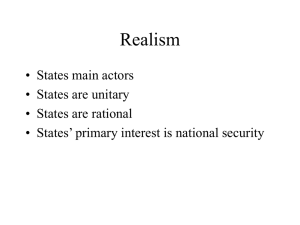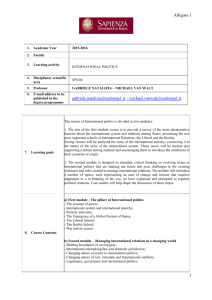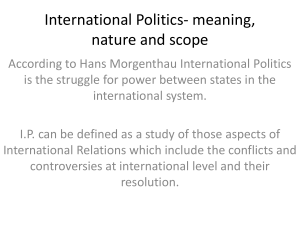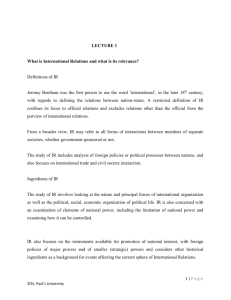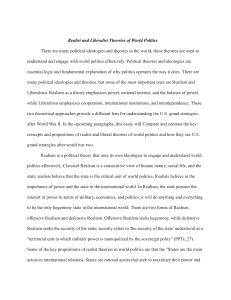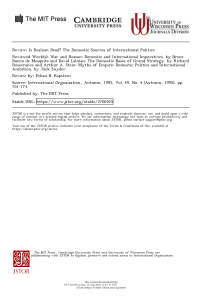CRITICAL PERPECTIVES ON ORGANIZATION
advertisement
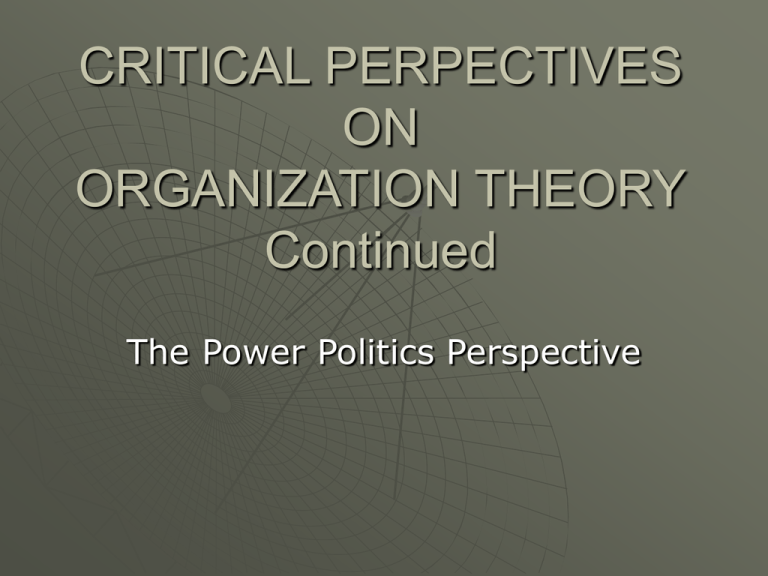
CRITICAL PERPECTIVES ON ORGANIZATION THEORY Continued The Power Politics Perspective Learning Objectives 1. 2. 3. Describe the role of power and politics in organizations State the main advantage and disadvantage of the power politics perspective on organization Understand the scope for the exercise of choice in terms of organizational design and change Political behavior in organizations Organizations are political system, coalitions of interests, and rationality is defined only with respect to unitary and consistent ordering of preferences Robbins (1986) remarked ‘a political view can explain much of irrational behavior in organizations’ Postmodernist take focus on relationship between power and knowledge and on the way that power is used to promote particular views of reality and to legitimate particular forms of knowledge in organizations Power and Politics Power is the possession of position and or resources Politics is the deployment of influence/leverage Robbins (1987) defines organizational politics is the efforts of organizational members to mobilize support for or against policies, rules, goals or other decisions in which the outcome will have some effect on them. Researcher Political behavior identifies 7 ploys used by manager when seeking to influence superiors, equals and subordinate: 1. Reason (most popular tactic/ploy) 2. Friendliness 3. Coalition 4. Bargaining 5. Assertiveness 6. Higher authority 7. sanctions Etzioni (1975) identified 4 distinct types of power used in organizations : 1. Coercive power 2. Remunerative power 3. Normative power 4. Knowledge power Managing and Changing Organizations Murray (1989), Morgan (1986) and Robbins (1987) said that process of organizational change is inherently a political one Pettigrew (1987) maintain that the process of change is shaped by: the interests and commitments of individuals and groups force of bureaucratic momentum significant change in the environment the manipulation of the the structural decisions THE REALIST PERSPECTIVE The realism is a reality “out there” waiting to be dicovered. Realism has been applied to the social sciences and explicitly applied it to management and organisations. Realism is a riposte to both modernism and postmodernism. The modernism object to the social construction side of the realist’ reality, whilst the postmodernism object to the realist’claim that there is only one reality and it can be discovered The Complexity perspective Complexity serves as an umbrella term for a number of theories, ideas and research programme that are derived from many different disiplines in the natural sciences. Complexity theories are concerned with the emergence of order in dynamic non linear system operating at the edge of chaos, such as weather systems, which are constantly changing and where the laws of cause and effect appear not to apply. The implications for organisations In considering complexity theories and organisational change, one of the key questions is to ask ”what’s new?” Implications for organisations : 1. There will be a need for much greater democracy and power equalisation in all aspects of organisational life, instead of just narrow employee partisipation in change 2. Small-scale incremental change and large-scale radical-transformational change will need to be rejected in favour of a third kind which lies between these two, and which is continous and based on self-organisation at the team/group level 3. In achieving effective change, order-generating rules have the potential to overcome the limitations of rational, linear, top-down, strategy-dirven approaches to change Summary 1. 2. 3. Power and politics are amongst the most important factors influencing decision making in organizations Organizations as shifting coalitions of groups and individuals seeking to promote policies, and decisions that enhanced or maintain their position in the organization Politics comes to the fore when major issue of structural change or resource allocation are concerned
